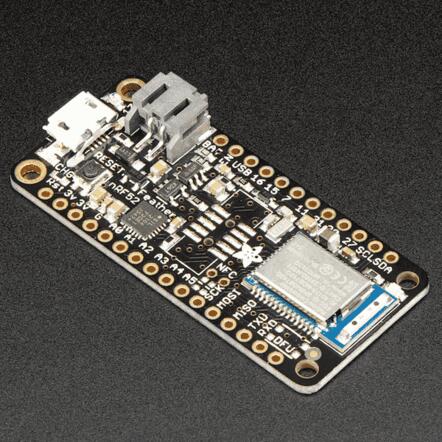nRF52 Adafruit Feather
Overview
The nRF52 Adafruit Bluefruit Feather hardware provides support for the Nordic Semiconductor nRF52832 ARM Cortex-M4F CPU and the following devices:
NVIC
RTC
UART
GPIO
FLASH
RADIO (Bluetooth Low Energy)
Segger RTT (RTT Console)

nRF52 Adafruit Feather Board (Credit: Adafruit)
More information about the board and its features can be found at the Adafruit Feather nRF52 Bluefruit Learning Guide [1]. The Nordic Semiconductor Infocenter [4] contains the processor’s information and the datasheet.
Hardware
nRF52832 ARM Cortex-M4F processor at 64 MHz
32.768 kHz crystal oscillator
512 KiB flash memory and 64 KiB of SRAM
Battery connector and charger for 3.7 V lithium polymer batteries
Charging indicator LED
2 User LEDs
Reset button
SWD connector
USB serial converter
Supported Features
The nRF52 Adafruit Feather board configuration supports the following hardware features:
Interface |
Controller |
Driver/Component |
|---|---|---|
NVIC |
on-chip |
nested vectored interrupt controller |
RTC |
on-chip |
system clock |
UART |
on-chip |
serial port |
GPIO |
on-chip |
gpio |
FLASH |
on-chip |
flash |
RADIO |
on-chip |
Bluetooth |
RTT |
on-chip |
console |
Other hardware features have not been enabled yet for this board.
Connections and IOs
The Adafruit Feather nRF52 Bluefruit Learning Guide [1] has detailed information about the board including pinouts [3] and the schematic [2].
LED
LED0 (red) = P0.17
LED1 (blue) = P0.19
Programming and Debugging
The nrf52_adafruit_feather board is available in two different versions:
- Adafruit Feather nRF52 Pro with myNewt Bootloader [6]
This board version is the recommended one to use. It has the SWD header already populated and comes with the Mynewt serial bootloader installed by default.
- Adafruit Feather nRF52 Bluefruit LE [5]
This board is identical to the board above, but the SWD header is not populated and ships with an Arduino friendly bootloader. To be able to work with this version a 2*5pin 0.5” SWD header (e.g. Adafruit SWD connector [7]) needs to be soldered.
Applications for the nrf52_adafruit_feather board configuration can be
built, flashed, and debugged in the usual way. See Building an Application
and Run an Application for more details on building and running.
Flashing
Flashing Zephyr onto the nrf52_adafruit_feather board requires an external
J-Link programmer. The programmer is attached to the X1 SWD header.
Follow the instructions in the Nordic nRF5x Segger J-Link page to install and configure all the necessary software. Further information can be found in Flashing. Then build and flash applications as usual (see Building an Application and Run an Application for more details).
Here is an example for the Hello World application.
Build the Zephyr kernel and the Hello World sample application:
west build -b nrf52_adafruit_feather samples/hello_worldConnect the Adafruit nRF52 Feather to your host computer using USB
Run your favorite terminal program to listen for output.
$ minicom -D <tty_device> -b 115200
Replace
<tty_device>with the port where the nRF52 Adafruit Feather board can be found. For example, under Linux,/dev/ttyUSB0.Flash the image:
west build -b nrf52_adafruit_feather samples/hello_world west flash
You should see “Hello World! nrf52_adafruit_feather” in your terminal.
Debugging
The nrf52_adafruit_feather board does not have an on-board J-Link debug IC
as some nRF5x development boards, however, instructions from the
Nordic nRF5x Segger J-Link page also apply to this board, with the additional step
of connecting an external debugger.
